Hollywood has been patting itself on the back recently for churning out “strong female characters.” It’s a term we hear thrown around a lot and the meaning of which has gotten flipped on its head, now mostly used in jest. Originally it came from audiences and actresses who were calling for more nuanced and complex roles for women on screen. It has now been hijacked by Hollywood as a term used to describe the same female trope over and over again. Essentially the exact opposite of the nuance or complexity that was being demanded. *Cough cough Game of Thrones.* Most of the time that has to do with the fact that these films and characters are being crafted by men who project their one track notion of what “strong” means without ever allowing women to sculpt their own representation.
Jessica Chastain even brought up this issue at Cannes this where she was a juror, explaining how disturbed she was by a lot of the films she watched regarding their portrayal of women. Women who were not remotely close to women she actually sees exist around her. When suggesting what needs to be done to improve upon this, Chastain stated “When we include more female storytellers, we will have more of the women I recognize in my day-to-day life—ones that are proactive, have their own agencies, don’t just react to the men around them. They have their own point of view.”
Patty Jenkins’ Wonder Woman has done just that. Gal Gadot’s Diana was truly a strong female character and complexly beautiful. Through Jenkins’ respectful lens, we’re allowed to go on a journey with Diana that so few mainstream female protagonists are allowed to go on.
Subverting the Action Girl Trope
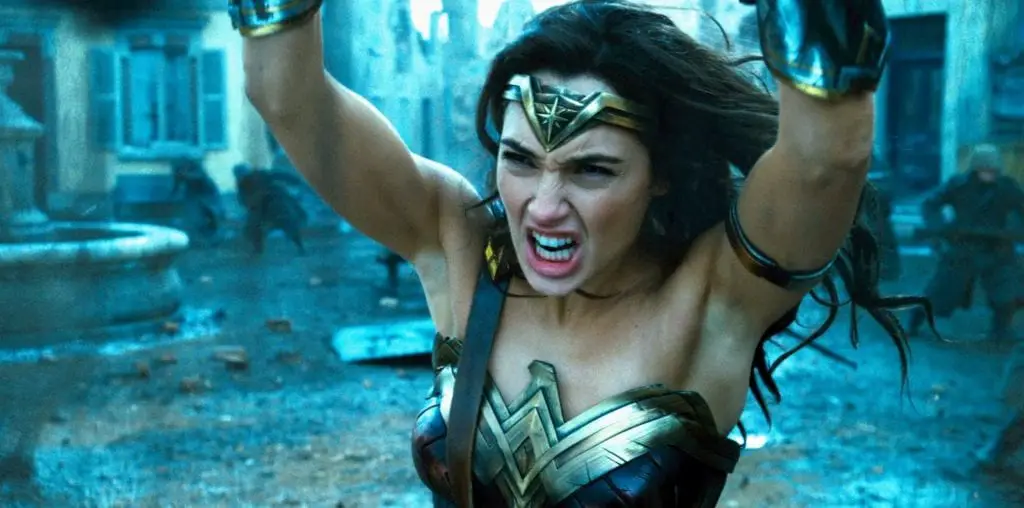
The Action Girl trope is one of the main components of the Strong Female Character (SFC)™ and highlights where Hollywood has interpreted the name both too literally and not literally enough. Action Girls are “badass” characters who can fight and are expertly skilled with weapons. On the surface, that doesn’t seem too bad, and I definitely want female action stars. However, when women are given this character trait, it becomes their defining feature in more damaging ways then one.
First of all, it’s completely fetishized. It’s all for the male gaze. What felt so life changing about Wonder Woman was that these women were allowed to be physically strong in actuality. It wasn’t exploitative or voyeuristic. It celebrated strength as such. All of the women trained really hard for months leading up to shooting, with six hour sessions a day of gym work, fight choreography, and horse back riding. They looked strong because they were strong. Not to mention Jenkins filled a great deal of Themyscira’s population with actual female athletes.
Usually when you see physically strong women in film, the men behind the camera don’t want her to actually be physically strong. Toned prominent muscles are looked at as a masculine trait. Women are allowed to appear to be strong on camera if they still resemble the impossible ideal of being pretty, skinny, yet also sexy, and somehow able to also kick ass.
However, Jenkins was clearly not concerned with any of that. These women went on the super hero regimen that male actors are constantly put through and rewarded for. Instead of the usual pattern of men putting on muscle and toning up at the gym for a big role while their female co-stairs are forced to lose weight, the women of Wonder Woman were allowed to be wonderfully and truly physically strong as well as look it. It’s one of the most incredibe things that I really hope inspires little girls watching. Strong is beautiful.
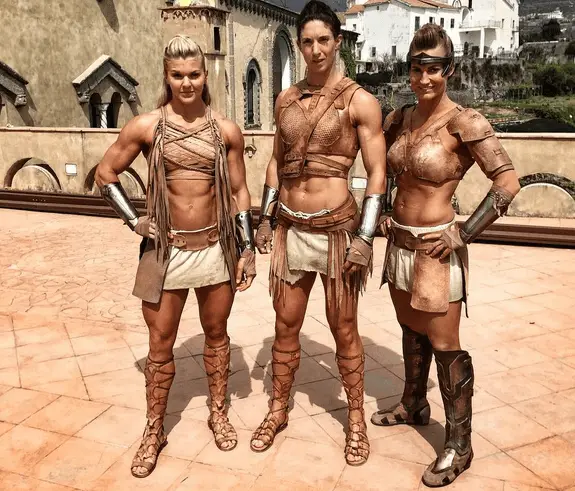
The film also explored what strength means. Fighting isn’t romanticized and neither is general “badassery” or strength for it’s own sake. There are consequences to fighting. For a female action star, or rather an action star in general, but specifically the Action Girl trope, fighting usually translates to being Badass™. They fight and so they are cool. They kill and hurt without a second glance.
In Wonder Woman, from the very beginning, Connie Nielsen’s Hippolyta tries to instill an awareness in young Diana that war and fighting is nothing to celebrate. These women all fight and have learned how to defend themselves, but the fighting is nothing to crave. It’s a precaution, not a hobby. I had hoped for this message before the movie came out, a message I’ve been craving in superhero flick after flick where death and war are a constant to the point of being a piece of background furniture.
Chris Pine (who plays Steve Trevor) has spoken about this a lot during the film’s press tour as one of its greatest strengths and its true. Gadot’s Wonder Woman is perhaps the first and only super hero we’ve seen as of late to understand what true strength means. Her strength isn’t in her violence but rather her compassion. She can fight, just as the Amazons have been trained to, but only fights to stop the fighting. Her whole goal for the film is to end the war that she believed Ares, the God of War, has caused. Her action sequences, while “badass,” do not leave her in a heartless blast of explosions and death. In fact, for the majority of the movie she only makes use of her shield and her lasso, weapons of defense and truth – not destruction.
Just Like Other Girls
On of the other most commonly and frustratingly used traits of a SFC™ is the Not Like Other Girls trope. It’s definitely one of the ones I hate the most. This frequently unnecessarily pits women against one another. It’s also one of the most celebrated tropes in certain parts of Hollywood. However, despite Wonder Woman’s plot literally revolving around her being a woman from an island of mythical Amazons and stepping into the reality of 1917 Europe, that trope never comes into play. In fact, it’s actively subverted.
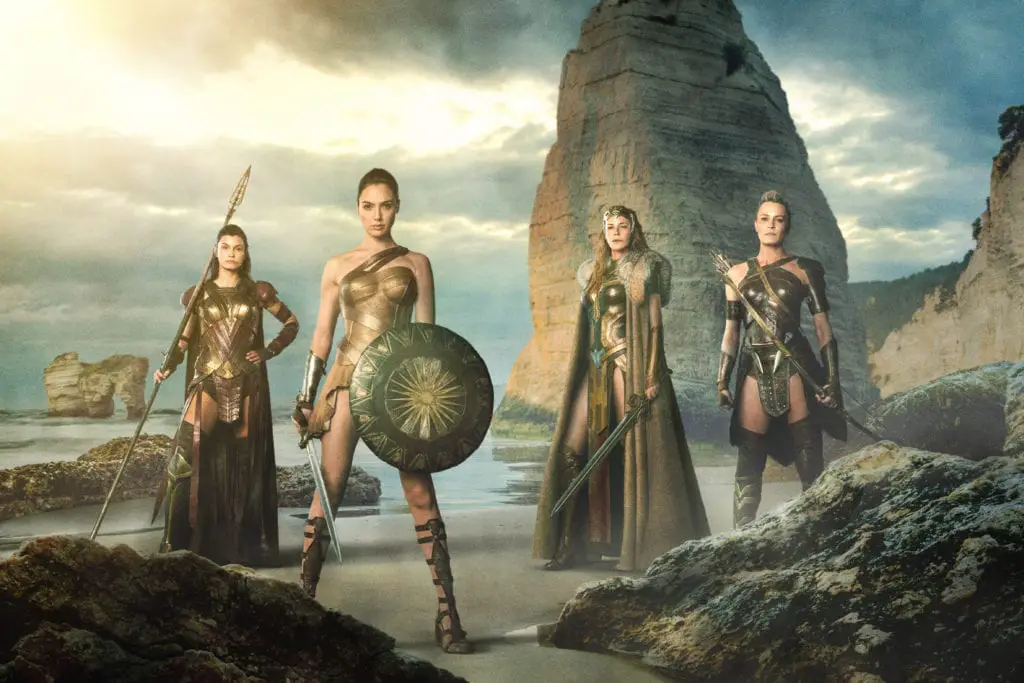
Diana comes from Themyscira, an island of Amazonian women. Women who we see working together, fighting for each other, and loving one another. Right off the bat, in a sequence that made yours truly tear up, we see our screens flooded with beautifully strong and compassionate women…and only them. We see them running this island, commanding armies, taking care of one another, and supporting each other.
The one aspect of the plot that would allow for this Not Like Other Girls trope to even see the light of day justifiably is thrown away. While Diana is literally not like any of the other women we see in the film, even the women she calls family, the film doesn’t reveal that to her or us until the very end. She doesn’t know she isn’t just an Amazon and grew up loving, respecting, and identifying with these women. Until the end she believes she is like them and hopes to live up to their reputation.
There is a moment that splendidly showcases how much respect she has for her fellow woman and how equal to them she feels. When she talks to Trevor about attempting to secure his freedom, she mentions she even asked if she could go with him to stop the war. Yet she then clarifies she means an Amazon—any Amazon. She recognizes and respects the power of all of them and doesn’t think she’s special. While we as an audience know of her legacy, she doesn’t. If it were up to her, she would trust sending any Amazon in her place. The film never builds her up to something special by tearing her fellow women down.
Not to mention her greatest relationships in the film are with women; her aunt Antiope and her mother, Hippolyta. (Which could be a whole article in itself.) But, as for subverting the trope, the film makes it clear they are essential to Diana’s growth. These two women are her primary caregivers and figureheads in her life growing up. They raise her.
So much of Diana’s character is built on of her relationships with each of these women, as is her emotional journey. Antiope teaches her that sometimes you have to fight to save, turning her into the compassionate warrior she becomes. Hippolyta teaches Diana the dangers of wartime and its horrors. From her mother she learns to never wish for war and from her aunt how to prepare for it should the day come. Not surprisingly, these two concepts embody Diana’s greatest strengths.
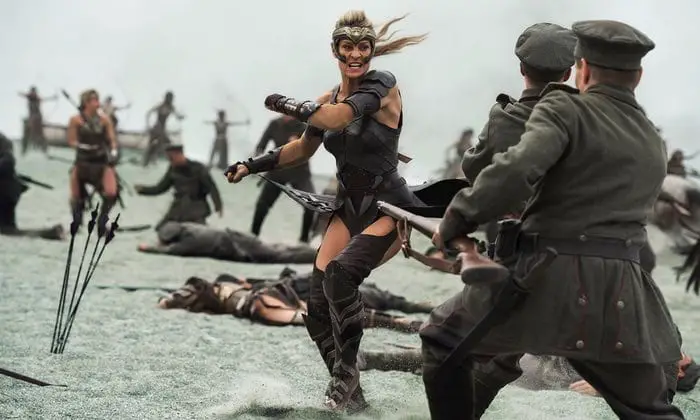
Emotional Struggle
Another of most common threads found in Hollywood’s idea of the SFC™ is making sure that she is completely unemotional. This goes with the Action Girl trope to make for a “badass” fighter that feels nothing. This comes from the fact that emotions are viewed as feminine traits and in dichotomy of the traits along the gender spectrum, feminine means weak. Women are only allowed to be one or the other. If they are “strong” (i.e., coded as traditionally masculine) then they cannot feel. If they are coded as stereotypically feminine, then they can only feel. Because apparently women work like a light switch.
But, not Diana. She’s allowed to go on the emotional journey that we’ve seen so many of our super male protagonists go on.
Diana’s greatest struggle in this film is all emotional and it’s something to cheer about. Her arc is that of a nuanced emotional struggle; her view of the world flips on its head. She learns to that the human world is complex and messy. There is no black and white answer for the battle between good and evil. Good and evil exists inside all human beings. As she learns that humanity itself embodies both the dark and the light, not because of a god’s tampering, she learns that the only thing you can do is fight with your heart.
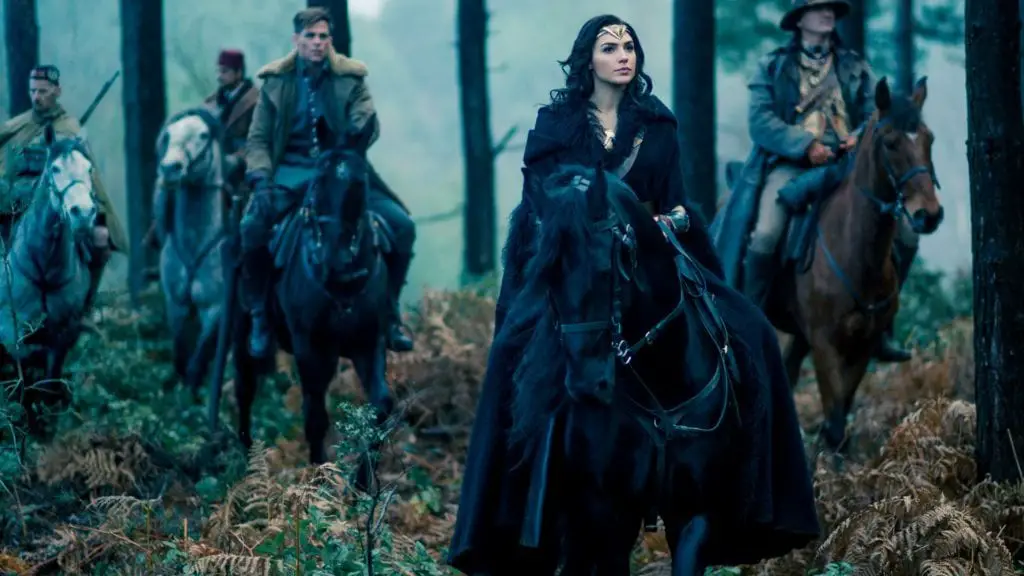
One of the best quotes in the film is when Diana talks to Trevor after she believes she killed Ares. She sees the fighting hasn’t stopped and doesn’t understand. She looks on with horror, realizing that the bad exists within human nature and there’s no wiping it out.
Diana tells Trevor that her mother was right, that the human race doesn’t deserve her help. But he argues that it’s not about deserve, rather about what you choose. In the end, Diana chooses love. Her ultimate choice, her ultimate moment of defiance in the climax of the film, is her choice to act with her heart. She chooses the emotionality that Hollywood has denied its Action Girls. She’s allowed to cry, to break, to scream, and to feel. She’s thrown into a situation filled with injustice and horror and comes away from all that with a resolve of love.
While no emotion is usually the SFC™’s strengths, it is not Diana’s. She wears her heart on her sleeve and it’s whats needed. In wartime, in a war so brutal, so devastating, one’s greatest strength is to not forget one’s humanity. One’s heart. Diana never forgets hers.
Agency With A Side of Romance
While there is definitely a romance in the film, it is not Diana’s whole story. And within itself, it showcases a beautiful agency and maturity that is never given to SFCs™. She can still be the action hero of the film while engaging in a relationship.
Every step of her relationship with Trevor was a choice on her end in a way that was miraculous to see on screen. The choice aspect of it all in the first place was what made it such a unique and real relationship despite the brief time they had together. For one, she kickstarts their interaction by saving him from his plane crash. From then on, she directs their relationship to the path it takes. It completely subverts that horrible “first love” stereotype where women fall head over heels and orbit around their partner. She and Trevor co-exist and their romantic relationship is a part of their interaction but it’s mature. There is no hesitance within her about saying no to him or speaking her mind. There’s no timidness when it comes to feelings. It’s two adults who are clearly attracted to one another and respect each other.
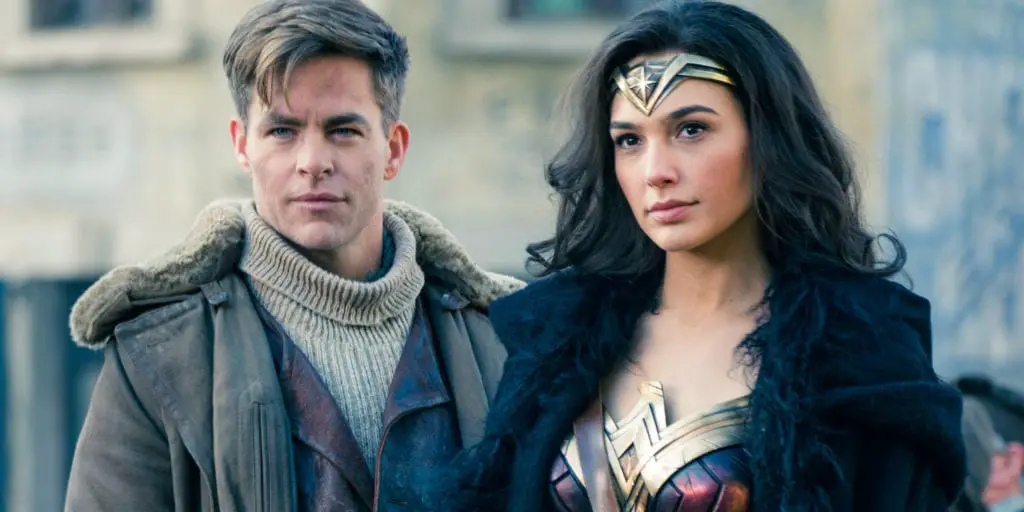
In fact, one of the most groundbreaking moments is a small and subtle scene, but so important. After the No Man’s Land sequence when the little village they saved is celebrating, the two share a dance (or a sway as Diana would say). While dancing, they talk about what people usually do after the fighting is over. It is so palpable and obvious that the two feel the same way about each other and they both decide to do something about it. They take the next step and spend the night together, and it is two adults making a choice. There is no shame or exploration, just unabashed, mature desire.
It’s also essentially a relationship between two colleagues and co-workers. So while it’s an incredibly sweet and tender relationship when the two are romantic, like adults they also separate that from when they are “working” on in the battlefield and when something greater takes precedence. Unlike in the Hunger Games films where many critics angrily decry the idea that Katniss would have time to constantly think about a love triangle, Wonder Woman showcases the reality of humanity.
The romantic and sexual part of human nature doesn’t just vanish when there is something greater going on, But when it comes time to deal with that something, especially when it involves people’s lives, that will take precedence. They both recognize their roles, as Trevor says when he choses self-sacrifice, noting that he’s the hero the world needs for that moment, but Diana is the hero the world will need forever.
Woman-Pain
One of the things that struck me the most about Wonder Woman’s climax was that it flipped a trope on its head that I don’t think I’ve ever seen fully flipped in actuality before. Everyone’s favorite ‘manpain’ trope. The amount of times we’ve seen many of our favorite female characters reduced to pointless deaths in order to further characterize and develop their male counterparts, or how I like to put it, allow for the men to feel “manpain” to make us connect further with them emotionally is more than I can count. How many female characters have we seen tossed on the train tracks in order for a male character to rise up from her ashes? To further develop or move the male character’s plot point forward? Too many. And for the first time, in albeit a less ham-fisted way and one that allows more agency, the opposite happened.
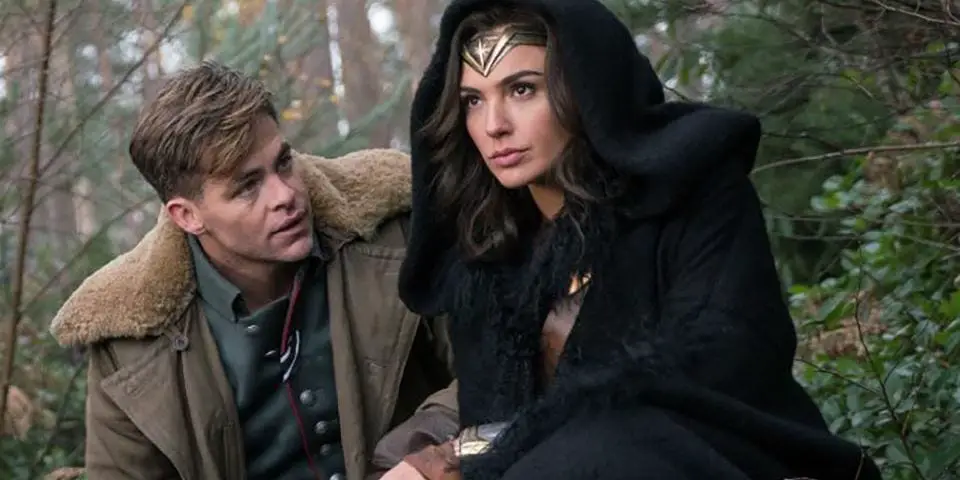
During the film’s climax, when Diana’s crushed under the weight of metal that Ares is holding her down with and she thinks of her last moments with Trevor. She sees his plane explode, screaming out in pain and agony. I cannot tell you how many times I’ve seen that scene with a man in her place. Yet of course, Trevor was given way more agency and development than any of the female characters are ever given in his stead.
Diana’s moment of “woman-pain” in its bare form does exactly what all those scenes with male protagonists have done. It furthers her character on her journey of realization and thematic emotional development. However, because of the strength with which their relationship and Trevor’s character were handled in the first place, for the first time it comes out of the story, It justly finishes both the protagonists arc and the arc of the romantic partner that has been killed off.
Thus, Wonder Woman definitely did what I asked of it and more. While in the current world of Hollywood, Diana could have easily been given the typical SFC™, she subverted all of it. She was allowed to be both strong and feminine. She was both powerful and weak. When she fought, she understood that fighting is no blessing. She was everything Superman should have been in Man of Steel and so much more. One can only hope that due to the financial and critical success, this film will set the standard for DC films, and female led superhero films, in the future.

